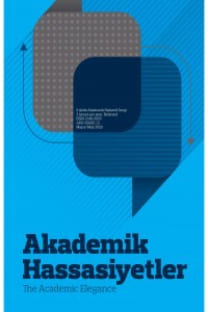KUZEY KORE DİJİTAL PROPAGANDA VE STRATEJİK İLETİŞİM İÇERİKLERİNİN ELEŞTİREL SÖYLEM ANALİZİ ARACILIĞIYLA İNCELENMESİ
Günümüzde bilginin üretilmesinin ve yönetilmesinin iktidarın elde edilmesinde en önemli araçlardan biri olduğu hakikati, propaganda kavramının özellikle otoriter devletler için önemli olduğunu ortaya çıkarmıştır. Bu bağlamda, basın özgürlüğüne sahip olmayan, otoriter bir ülke olarak Kuzey Kore bilginin iktidarını ele geçirmiş ve muhtelif propaganda yöntemleri benimsemiştir. Dijital dönüşümlere adapte olmaya çalışan Kuzey Kore, interneti bir propaganda vasıtası olarak kullanmaya başlamıştır. Haliyle bu durum, propagandanın dijitalleşmesini beraberinde getirmektedir. Bu makale, dört Kuzey Kore haber metninin eleştirel söylem analizi ile Kuzey Kore’nin dijital propaganda ve stratejik iletişim yöntemlerini incelemektedir. Makalenin metodolojisi Teun A. van Dijk’in haber söylem analizi olarak belirlenmiştir. Bu kapsamda, propaganda ve stratejik iletişim kavramları arasında bir ilişki olup olmadığı ortaya konmaya çalışılmış, propaganda içeriklerinin döneme bağlı söylemsel değişimleri ele alınmıştır. Eleştirel söylem analizinin güç-iktidar ilişkisi ve bu ilişkinin söyleme yansımaları olduğu iddiası, Kuzey Kore propaganda içerikleri ile desteklenmiştir.
Anahtar Kelimeler:
Dijital Propaganda, Stratejik İletişim, Kuzey Kore, Eleştirel Söylem Analizi
EXAMINATION OF THE NORTH KOREAN DIGITAL PROPAGANDA AND STRATEGIC COMMUNICATION CONTENTS THROUGH CRITICAL DISCOURSE ANALYSIS
The fact that the production and management of information is one of the most remarkable means of obtaining power has disclosed the concept of propaganda is especially crucial for authoritarian states. In this framework, The North Korea, as an authoritarian country without freedom of the press, seized the power of information and adopted various propaganda methods. Trying to adapt to digital transformations, the North Korea has benefited from the internet as a propaganda tool. Naturally, this brings along the digitalisation of propaganda. This article scrutinises the North Korea's digital propaganda and strategic communication methods through a critical discourse analysis of four North Korean news texts. The method of the article was determined based on Teun A. van Dijk's news discourse analysis. In this context, it has been tried to reveal whether there is a relationship between the concepts of propaganda and strategic communication. Besides the discursive changes of the propaganda contents depending on the period have been discussed. The claim that the critical discourse analysis has the authority-power relationship and the reflections of this relationship on discourse have been supported by the North Korean propaganda.
___
- Beds SU. (n.y.). BEDS SU digital communication strategy. Retrieved from https://s3-eu-west 1.amazonaws.com/nusdigital/document/documents/48549/3ee5803a4df4c9457b2a2fc39ebe592c/CS2017_Appendix_3_Digital_Communication_Strategy.pdf on 20.11.2022
- Beyazyüz, S. (2021). Projection of orientalist elements: white man’s burden. In I. Tombul & G. Sarı (Eds.), Handbook of research on contemporary approaches to orientalism in media and beyond (pp. 507-535). AMEA.
- Bjola, C. (2018). The ethics of countering digital propaganda. Ethics and International Affairs, 32(3), 305-315. https://doi.org/10.1017/S0892679418000436
- Conserva, H. T. (2003). Propaganda techniques. San Bernadino: 1st Book Library. Defense Science Board. (2004). Report of the defense science board task force on strategic communication. Washington: Defense Science Board.
- Derina Holtzhausen, A. Z. (2015). The routledge handbook of strategic communication. Oxon: Taylor & Francis.
- Dijk, T. A. (2000). Ideology and discourse a multidisciplinary introduction. Retrieved from http://www.dscursos.org/unpublished%20articles/Ideology%20and%20discourse.pdf on 19.11.2022
- Dijk, T. A. (2001). Critical discourse analysis. In D. T. Deborah Schiffrin (Ed.), The handbook of discourse analysis (pp. 352-371). Blackwell Publishers.
- Dijk, T. A. (2006). Ideology and discourse analysis. Journal of Political Ideologies, 11(2), 115-140. https://doi.org/10.1080/13569310600687908
- Drucker, P. F. (1998). The next information revolution. Retrieved from http://www.s-jtech.com/Peter%20Drucker%20-%20the%20Next%20Information%20Revolution.pdf on 17.11.2022 European Parliament. (2021). Strategic communications as a key factor in countering hybrid threats. Brussels: European Parliament.
- Fairclough, N. (1995). Media discourse. London: Edward Arnold.
- Günay, D. (2018). Söylem çözümlemesi. İstanbul: Papatya Yayıncılık Eğitim.
- Graham, P. (2017). Strategic communication, corporatism and eternal crisis. Oxon: Routledge.
- Hallahan, K., Holtzhausen, D.R., van Ruler, B. & Vercic, D. (2007). Defining strategic communication. International Journal of Strategic Communication, 1(1), 3-35. https://doi.org/10.1080/15531180701285244
- Jowett, G. & O'Donnell, V. (2012). Propaganda and persuasion. California: Sage Publication.
- Laswell, H. D. (1927). The theory of political propaganda. American Political Science Review, 21(3). https://doi.org/10.2307/1945515
- Min, T. & Huhe, N. (2020). Parsing the effect of the internet on regime support in china. Government and Opposition, 55(20), 130-146. https://doi.org/10.1017/gov.2017.39
- North Korea Tech. (2010, December 7). Ryugyong clip. 38 Korea. Retrieved from https://www.northkoreatech.org/the-north-korean-website-list/ryugyong-clip/ on 23.11.2022
- Özer, Ö. (2001). Haber söylem ideoloji: eleştirel haber çözümlemeleri. Konya: Literatürk Yayınevi.
- Park, C. (2020). 북한의 선전화와 직관선동: 선전 선동의 내면화 과정 연구. Korean Bulletin of Art History (54), 205-221. https://doi.org/10.15819/rah.2020..54.205
- Paul, C. (2011). Strategic communication: origins, concepts, and current debates. California: Praeger.
- Reporters Without Borders. (2022). World press freedom index. Retrieved from https://rsf.org/en/index on 29.11.2022
- RN, T. M. (2008). Strategic communication: a primer. Advanced Research and Assessment Group.
- Ryugyong. (2018, October 17). Era of independent reunification, peace and prosperity ushered in by great over for nation. Retrieved from http://www.ryugyongclip.com/index.php?type=gisa&categ=7&no=16478 on 24.10.2022
- Ryungyong. (2018). 《김정은위원장의 파격행보로 평양남북정상회담에서 〈최초〉, 〈처음〉이 쏟아졌다》. Retrieved from http://www.ryugyongclip.com/index.php?type=gisa&categ=4&no=16338 on 23.10.2022
- Taylor, P. M. (1990). Munitions of the mind: war propaganda from the ancient world to the nuclear age. Wellingborough: Patrick Stephens Ltd.
- The Pyongyang Times. (2022). Retrieved from http://www.pyongyangtimes.com.kp/?pdf on 15.10.2022
- The Pyongyang Times. (2022, November 19). WPK solemnly declares its immutable ill to react to enemy’s nuke and full-frontal confrontation in kind. Retrieved from http://www.pyongyangtimes.com.kp/blog?page=revolutionary&blogid=637879821c468905c4ac9644 on 25.11.2022
- Uriminzokkiri. (2022). 전쟁광신자의 정체는 절대로 가리울수 없다. Retrieved from http://www.uriminzokkiri.com/index.php?ptype=cgisas&mtype=view&no=1236184 on 01.12.2022
- Wilbur, D. (2017). Propaganda’s place in strategic communication: the case of ISIL’s dabiq magazine. International Journal of Strategic Communication, 11(3), 209-223. https://doi.org/10.1080/1553118X.2017.1317636
- ISSN: 2148-5933
- Yayın Aralığı: Yılda 3 Sayı
- Başlangıç: 2014
- Yayıncı: A Kitap
Sayıdaki Diğer Makaleler
MULTIFACETED FINANCIAL DEVELOPMENT AND ECONOMIC GROWTH: BOOTSTRAP PANEL CAUSALITY APPROACH
TUKİDİDES TUZAĞI ÇERÇEVESİNDE ABD –ÇİN REKABETİNİN ANALİZİ: TEORİK BİR DEĞERLENDİRME
DEMOKRASİ TEORİSİNDE EŞİTLİK PROBLEMİ: BİR KATEGORİZASYON ÖNERİSİ
Itır HASIRCI, Edip ÖRÜCÜ, Pınar KURT
Hatice BATMANTAŞ, Fatma ZEYBEK
SÜRDÜRÜLEBİLİR TÜKETİM DAVRANIŞININ ETKENLERİ: TÜRKİYE'DE Z KUŞAĞI ÜZERİNE BİR SAHA ARAŞTIRMASI
